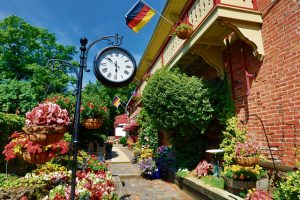
The Kaiserslautern Military Community is located in and around the county, right in the heart of the Pfalz (Palatinate). Anyone who has learned high German can certainly refer to the fact that the strong dialect spoken in the region is far from anything learned in German class. A German from the north may have trouble understanding speakers with strong dialect. But, did you know that there are about 100,000 people, mainly in Pennsylvania and Ohio that speak, or a variation of, this dialect?
The Institut für Pfälzische Geschichte und Volkskunde, Institute for Palatinate History and Ethnology, is based in Kaiserslautern and has records of about 300,000 emigrants from the region who emigrated from 1650 onwards, mainly in the 18th and 19th centuries.
The Palatinate emigration was primarily driven by a quest for religious freedom, economic opportunity, and escape from political turmoil. Some emigrants went to South America, Africa and even Australia in later years, but the majority fled to America, such as religious minorities, including Mennonites, Amish, and various Protestant groups that sought refuge from persecution. Additionally, economic hardships, such as crop failures and oppressive taxation, pushed many to seek better prospects abroad.
Once in America, many settled in rural areas, establishing tight-knit farming communities that retained elements of their German heritage and language or local dialect. The Palatinate, or Pfälzisch, dialect is a mixture of Middle High German (spoken in the Middle Ages), French and Dutch influence, and local peculiarities.
One of the legacies of the Palatinate emigration is the preservation of the Pennsylvania German dialect, also known as Pennsylvania Dutch or Pennsylvania Deitsh. This distinctive language continues to be spoken by descendants of Palatinate immigrants in pockets of Pennsylvania and beyond. While its usage has declined over the years, efforts to preserve and promote Pennsylvania German culture persist through language classes, cultural events, and heritage organizations.
As an example a Pfälzer in the region might say (also in variations) “Isch hann, isch hunn, isch hab e Grumbeersagg” (German: Ich habe einen Kartoffelsack). A speaker of Pennsylvania Deitsh would probably understand that the speaker has a potato sack. The Amish tradition of Rumspringa, where adolescents gain permission to venture out and experience greater society, derives from the German verb (he)rumspringen, meaning to jump around.
Popular dishes such as Pfälzer Saumagen (stuffed pig stomach), Latwersch (plum jam), Grummbeersupp (potato soup), Dampnurrle (steamed dumplings), Brodwerscht (bratwurst) and traditional tasty baked goods are commonly still prepared there today. Many small towns celebrate German or Palatinate festivals throughout the year to keep traditions alive and young people interested in their roots take classes to (re)learn the dialect and popular songs.
The small community of Kutztown in eastern Pennsylvania, also known as Kutzeschteddel, with its 4,100 inhabitants, is famous for its annual festival. The nine-day event draws visitors from around the world and is the oldest continuous folklife festival in the United States. Visitors can experience insight into traditions of the Pennsylvania Dutch, see talented craftsmen weaving baskets, carpenters and blacksmiths demonstrating traditional skills, enjoy typical music and taste delicious baked goods, sausages and wines.
Many of the emigrants from the Palatinate maintained their homeland dialect and held close ties to their relatives at home. A newspaper called “Der Pfälzer in Amerika” was founded in New York in 1880 by the brothers Voelcker from Edenkoben. The paper was intended to keep immigrants informed about their homeland from 1884 to 1917. Original copies of the original newspaper are kept at the IPGV archives. Another paper entitled “Hiwwe wie driwwe” was established in the 1990s and published in Palatinate dialect. In addition, the County of Kaiserslautern has enjoyed close ties to Lancaster County, Pennsylvania for sixty years.
The Palatinate emigration produced several notable individuals, such as Johann Jacob Zimmerman, a skilled artisan and architect credited with designing iconic Pennsylvania German-style barns and homes. Peter Muhlenberg, a clergyman and military leader, played a pivotal role in the American Revolution, rallying his fellow Palatinate immigrants to the cause of independence. Conrad Weiser, a diplomat and interpreter, facilitated peaceful relations between colonists and Native American tribes.
Isidor Straus from Otterberg served as a congressman and became co-owner of Macy’s Department Store in New York City. Thomas Nast, born in Landau, arrived with his family at the age of six and became one of the most influential political cartoonists of the 19th century. He is best known for his depictions of the Republican Party elephant and the Democratic Party donkey. Nast’s keen eye for social justice also found expression in his powerful portrayals of issues such as slavery, corruption, and civil rights, earning him widespread acclaim and he is famous for creating a drawing of “Santa Claus,” based on the Protestant character of “Belznickel,” later instrumentalized and colored in red by the Coca Cola Company.
In addition, scores of adventurous musicians from the “Musikantenland” in the region set sail to the New World to seek their fortunes and founded their own orchestras. Ensembles such as the “Mackenbacher Wandermusikanten” were rather popular in areas with high German descendent populations.
Some of the wandering musicians returned to their hometown, but some stayed and even became famous throughout America. Heinrich Jacob from Mackenbach was one of these musicians who emigrated to New York and was successful under his artist name “Bill Henry” and his band called “Headliners.” Karl Schirra from Miesenbach played in ensembles in Boston, Brooklyn and Philadelphia after World War I.
If you are, or think that you are a descendent of a Palatinate immigrant, you may wish to contact the IPGV. It is currently working on enlarging its data base to simplify research for those interested in tracing their roots. It also collects original handwritten letters from emigrants to their families at home and has a library with 30,000 books. For more information visit: https://www.pfalzgeschichte.de/en/
Vitt Du Deitsh shvetza? Eich Mannsleit und Weibsleit viel Freid beim lese unn e schee Zeit! Odda rutsche mer de Buckel nunner!


